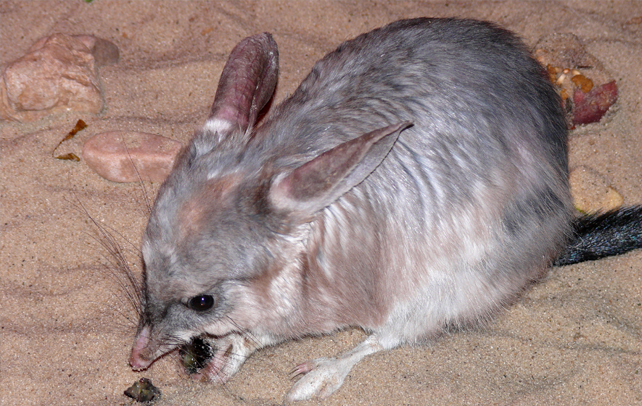Interesting Information About Greater Bilby

Greater bilby, dalgyte, or greater bandicoot, is a marsupial hailing from Australia. It is the only other rare species of the family after lesser bilby, which became extinct in the 1950s. The main reasons behind decline in the number of these marsupials during twentieth century are: increase in agricultural activities which resulted in destruction of their habitats, preying by several predators like foxes, and their hunting by humans for their skin. Their diet of is also considered a crucial aspect in the decline of their numbers as most of them die after eating the poisonous bates intended to feed rabbits to control their number. Today, however, greater bilbies are protected animals in their fatherland Australia and have been declared as ‘Vulnerable’ species. Following sub-section will take you on a tour of interesting and amazing facts about them.
Fast Facts
Scientific Name: Macrotis Lagotis
Kingdom: Animalia
Phylum: Chordata
Class: Mammalia
Infraclass: Marsupialia
Order: Peramelemorphia
Family: Thylacomyidae
Genus: Macrotis
Species: M. lagotis
Subspecies: Macrotis lagotis lagotis & Macrotis. lagotis sagitta
Body Length: up to 55 centimetres
Tail Length: up to 29 centimetres
Weight: 0.8 to 2.5 kg; males are larger in size than females
Life Span: 3 to 5 years in the wild; up to 10 years in captivity
Diet: Omnivore; insects and their larvae, seeds, spiders, bulbs, fruit, and fungi
Habitat: Semi-desert areas, grassland, woodland and savannah
Range: Western and South Western Australia
Age of Sexual Maturity: 6 months
Gestation Period: roughly 2 weeks
Average Litter Size: 2 (up to 4 in favourable conditions)
Interesting & Fun Facts About Greater Bilby
- The greater bilby comes from the family of marsupials known as bandicoots. It is the largest among all the members of the family.
- According to the AustralianNationalUniversity, the animal has derived its name from an aboriginal language ‘Yuwaalaraay’.
- Its black coloured eyes, nearly 1 centimetre in diameter, do not make clear vision. Due to the poor vision, it solely relies on its strong sense of hearing and smell. The eyes are protected with the help of fine black eyelashes.
- Built of a greater bilby comprises of long pointed nose, large hairless ears, white underside, black tail with a white crest. Because of its large ears, it is also known as Rabbit-Eared Bandicoot.
- The large ears of bilby aid in its effective hearing, as well as, strive to regulate its body temperature. They are also exceptionally manoeuvrable and can be rotated, made to stand flat against the body, positioned at right angles to the body and can even be folded in half.
- The soft and silky fuzz of bilby is primarily of pale blue-grey colours, with white and cream coloured undersides and feet.
- The stretched nose with hairless pink tip gives bilby an ability to smell sharply and smartly. You can witness many long, dark fuzz stick out from either side of the snout.
- A bilby has long slim tongue and 48 teeth: 26 on upper jaw and 22 on lower.
- It has slightly curved claws on the toes of its front feet. Whereas, on the feet of its hind legs, the second and third toes have slight joints with much larger fourth toe.
- Its claws and front legs are very strong which help it dig for its food and make deep burrows. An expert in digging, a bilby can dig up to a dozen of burrows. These burrows are generally spiral and as much as 3 meters deep.
- When a female bilby digs the soil, the dirt does not fill in its pouch as the pouch of a bilby opens in backward direction.
- The weight of an adult male bilby can go up to 2.5 kg. The weight of adult female bilby on the other hand, is significantly less (sometimes half) than that of an adult male.
- These are the nocturnal creatures that came out of their burrows nearly an hour after sunset and often go back in their burrows before first rays of the sun.
- The tail of a bibly is divided into three distinct sections: in the begining for a few centimetres, the colour of the tail resemble blue-greyish colour of the body; the middle section of the tail is black coloured, and at the end the tail is white.
- Bilby is a solitary animal, which prefers to roam alone. Although sometimes, bilbies are also seen in groups with at the most four members.
- Given that there is sufficient rainfall and food is available to them, bilbies can breed throughout the year.
- Having the smallest gestation period of all the mammals, greater bilbies breed one to three young bilbies in a litter.
- Infant bilbies remain in the pouch of their mother for nearly 80 days. It takes further 2 weeks till they become independent.
- Bilbies are the omnivorous creatures. Their food ranges from seeds, fruits, fungi to spiders, bulbs, small animals, insects and their larvae.
- A greater bilby consumes significant amount of mud along with its food.
- Bilbies do not drink water; rather, their food provides them with the requisite level of water to survive.
- Previously, they were hunted by Australians for food and fur. Other than humans, today they are preyed by foxes and feral cats.
- Before the European settlement, nearly 70% of the Australian Mainland had bilbies.
- At present, they are mostly seen in the south-west Queenslandand secluded parts of Western Australiaand the Northern Territory.
- The isolations of each of their colonies make them even more susceptible to diseases and inbreeding.
- The Northern Territoryand Western Australiahas declared bilbies as ‘Vulnerable’ animals. Queensland has listed them as ‘Endangered’ whereas in several other parts of mainland states, they have been categorized under ‘Extinct’ species.









